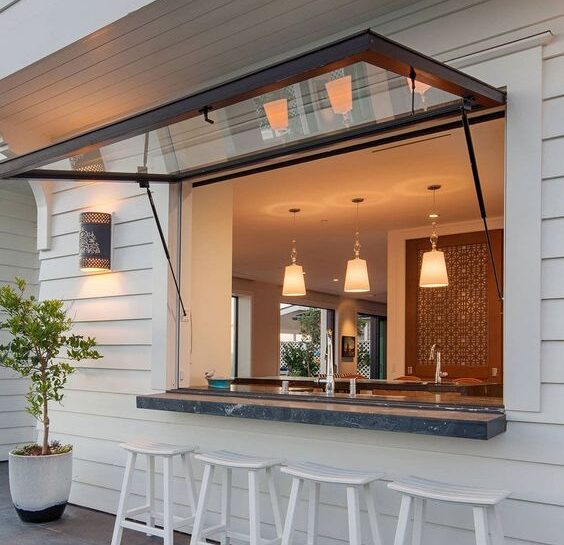In the dynamic world of construction and building materials, the “Flip Up Window” is a remarkable blend of convenience and style.
This innovative window design is gaining traction among builders, wholesalers, and contractors who seek practical yet aesthetically pleasing solutions for modern structures.
As we delve into the world of flip-up windows, we will uncover their unique features and benefits and why they are becoming a preferred choice in contemporary architecture.
What is a Flip Up Window?
As its name suggests, a flip-up window opens by flipping upwards. Unlike traditional sliding or casement windows, the flip-up window operates on a hinge at the top, allowing it to open outward and upward.
This design is particularly beneficial in tight spaces where traditional window sashes would be obstructive. The Flip up window offers an ingenious solution in urban environments where every inch of space counts.
Made from durable materials like uPVC, aluminum, and glass, flip-up windows offer a sleek and modern look that can enhance the aesthetic appeal of any building.

Flip-Up Windows: Key Features and Benefits
Here are some highlighted features of flip-up windows:
- Effortless Operation: Flip-up windows are easy to use, requiring just one hand ideal for high spaces or areas above counters. For accessibility considerations, see the ADA Standards for Accessible Design.
- Unparalleled Ventilation: The unique opening mechanism allows precise ventilation control. This adaptability makes flip-up windows ideal for kitchens, bathrooms, or anywhere fresh air circulation is key.
- Unhindered Views: Flip-up windows maximize unobstructed views, transforming any room into a haven of breathtaking scenery. Whether it’s a city skyline or a rolling countryside vista, these windows invite the outdoors in with uninhibited clarity.
- Energy Efficiency Champion: As sustainability champions, builders and contractors know the value of energy-efficient solutions. When closed, flip-up windows create a tight seal that minimizes heat loss and air infiltration.
- Aesthetic Allure: Flip-up windows add a modern and sophisticated touch to any architectural design. Available in many materials and finishes, they blend with contemporary builds or add a touch of whimsy to traditional facades.
Flip Up Windows vs. Awning Windows
Understanding the difference between flip up windows and awning windows is crucial for builders, wholesalers, and contractors in making informed decisions for their projects. The primary distinction between flip-up and awning windows lies in their degree of opening.
While both serve similar purposes, their differences in design, functionality, and ideal use cases set them apart.
| Feature | Flip-Up Windows | Awning Windows |
|---|---|---|
| Degree of Opening | Opens up to 90°, using a gas strut mechanism for smooth operation. | Limited opening range, uses a friction stay mechanism. |
| Mechanism & Operation | Hinged at the top, opens outward from the bottom, flipping up. Saves interior space. | Hinged at the top, opens outward from the bottom. Allows ventilation while keeping out rain. |
| Space Efficiency & Placement | Ideal for tight spaces (small kitchens, bathrooms, basements). Does not occupy interior space when open. | Best above sinks or bathrooms; less space-efficient but offers better rain protection. |
| Aesthetic & Design | Modern and sleek, customizable in various designs and finishes for contemporary styles. | Classic look, commonly used in traditional homes. Limited design flexibility. |
| Ideal Use Cases & Versatility | Perfect for modern residential/commercial spaces, especially urban settings where space matters. | Preferred in rain-prone areas; great for traditional homes needing weather protection. |
Why It Matters
Flip-up windows combine practicality with modern design, making them an ideal solution for builders, wholesalers, and contractors seeking both functionality and style.
Their unique design, ease of use, and aesthetic appeal make them a versatile addition to any construction or renovation project.
For those in the building industry looking to incorporate these innovative windows into their projects, visit www.oridow.com for a wide range of flip up window options. Contact us today to explore how our flip-up windows can enhance your next project!
FAQs
1. What is a flip-up window?
A flip-up window is a type of window that opens upward on a hinge at the top, allowing the sash to flip outward and upward. It is ideal for tight spaces and modern architectural designs.
2. How does a flip-up window work?
Flip-up windows operate using a hinge mechanism at the top and often include gas struts for smooth opening and closing. This design enables effortless one-handed operation.
3. Where are flip-up windows commonly used?
They are perfect for areas with space constraints, such as kitchens, bathrooms, offices, and urban apartments, as well as commercial spaces that require maximum ventilation and aesthetic appeal.
4. What materials are flip-up windows made from?
Flip-up windows are typically made from uPVC, aluminum, and high-quality glass, offering durability, energy efficiency, and modern style.
5. Are flip-up windows energy efficient?
Yes, when closed, flip-up windows form a tight seal, reducing air infiltration and heat loss, which contributes to energy efficiency in buildings.
6. What are the benefits of flip-up windows over traditional windows?
-
Space-saving design
-
Superior ventilation control
-
Unobstructed views
-
Energy efficiency
-
Sleek and modern aesthetics
7. How do flip-up windows compare to awning windows?
-
Degree of Opening: Flip-up windows open up to 90 degrees, while awning windows have a limited range.
-
Mechanism: Flip-up windows use gas struts; awning windows use friction stays.
-
Design: Flip-up windows are modern; awning windows have a more traditional appeal.
8. Can flip-up windows be customized?
Yes, they are available in various materials, colors, and finishes to match different architectural styles.
9. Are flip-up windows suitable for rainy weather?
While flip-up windows provide great ventilation, they are not as rain-resistant as awning windows. In areas with frequent rain, awning windows may be a better option.
10. Where can I buy high-quality flip-up windows?
You can find premium flip-up windows at Oridow, which offers a wide range of options for residential and commercial projects.





